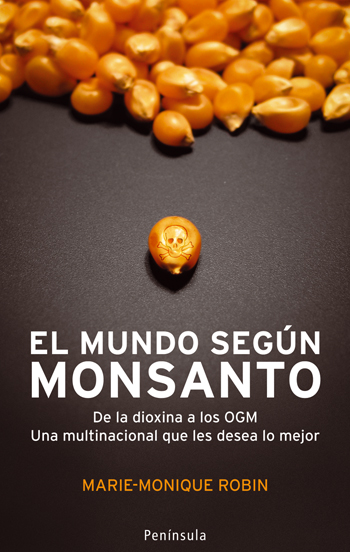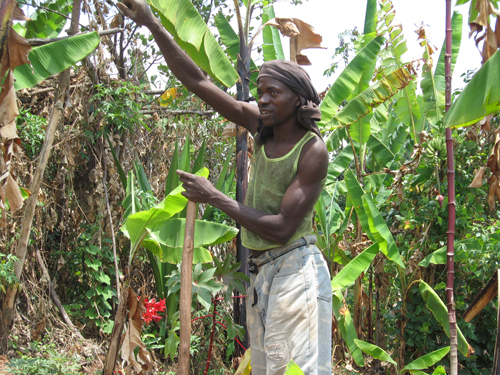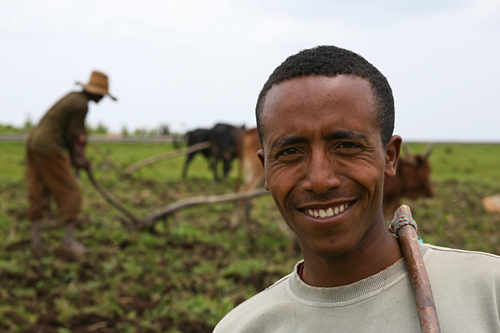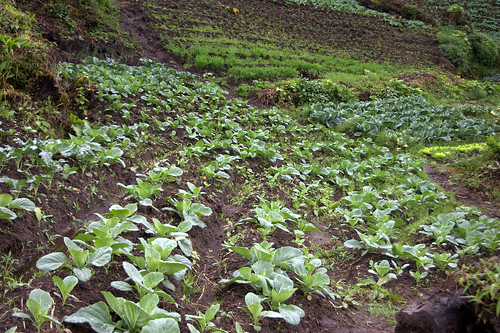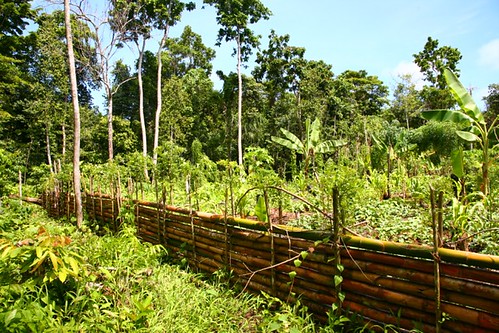
Food Without Fossil Fuels Now
Dr. Mae-Wan Ho
Invited Keynote Lecture, 2nd Mediterranean Conference on Organic Agriculture in Croatia, Organic Agriculture – Contribution to Sustainable Ecosystem, 2-6 April 2008, Dubrovnik University. Dubrovnik, Croatia
READ THE WHOLE ARTICLE AT: http://www.i-sis.org.uk/foodWithoutFossilFuels.php
Excerpt:
2008 the year of global food crisis
2008 has been designated the year of global food crisis by the United Nations [2-4]. The crisis has been building up over the past decades, but things have come to a head. Agricultural production has fallen below consumption for 7 out of the past 8 years, and world grain reserves are at the lowest since records began in the 1970s. To a large extent, this is a long-term trend reflecting the failure of industrial Green Revolution agriculture, and this very failure has been used to promote genetically modified (GM) crops as the new “doubly green” revolution [5] (Beware the New "Doubly Green Revolution", SiS 37).
But within the past year, world food prices suddenly went up by an average of 40 percent. That leaves the World Food Programme to feed 73 million people in 78 countries – not even one-tenth of the world’s hungry – with a shortfall of US$500 million. In addition, 36 countries have declared a food crisis as of December 2007.
There have been food riots and protests in many countries around the world: Mexico, Yemen, Morocco, Mauritania, Senegal, Uzbekistan, Egypt, Burkina Faso, Cameroon, even Italy, and the UK, where pig farmers can’t make a living because feed prices have doubled [6]. India has been hit by an epidemic of farmers’ suicide at an average of 10 000 a year before escalating to 16 000 a year when GM crops were introduced (see Chapter 23 of our Report [1]). But in 2007, a record 25 000 farmers took their own lives [4].
What has precipitated this food crisis? Many commentators blame China and India, countries with rapidly growing economies. People there are becoming well off and eating too much meat, like Europeans and Americans. The record suicides in India speak volumes against the idea that Indians are becoming ‘well off’.
On recent visits to China, we found restaurants and local markets everywhere full of food of all kinds: fresh fruits and vegetables, fish, seafood, meats, sausages, wind-dried meats, honey, grains, pulses, dried mushrooms, lichens, dried jelly fish and other produce of the sea, and a variety of snacks, both cooked and raw, processed or preserved. People’s Daily, the official Chinese government newspaper issued a rebuttal, rejecting as “groundless” the accusation that China has been responsible for the food price hikes [7], saying that “China’s grain yields have steadily grown from 2004 to 2007, and grain reserves have increased accordingly”. During 2007, China exported 9.2 million tonnes of cereals and imported 1.44 tonnes; so export exceeded import by a factor of 4.9. The article conceded that food prices in China have gone up, and the Government has cancelled export rebate in order to discourage exports to stabilize food prices in the country.
Biofuels are to blame for the food crisis
A major contributing factor to the build up of the food crisis is ‘peak oil’ [8] (Oil Running Out, SiS 25). According to a recent analysis, production figures showed that oil has peaked in 2006 [9]. Petroleum prices reached a record $105 a barrel last year, which has certainly driven food and feed prices up because conventional agriculture is heavily dependent on synthetic fertilizers, pesticides, water and machinery, all of which require fossil fuels. But the immediate cause of the present food crisis is something else - an intensified production of biofuels in Europe and the United States - that is having widespread repercussions on the availability of food because biofuels use our food as feedstock.
The United States divested a quarter of its corn harvests to producing ethanol in 2007, and in 2008, this will increase to a third. The US supplies more than 60 percent of the world’s corn exports and 40 percent of all cereal exports [2-4]. Other grains turned into biofuels are soybeans, wheat, and oilseed rape. And forests are being chopped down to grow soybeans and other feedstock such as oil palm, sugarcane, and jatropha, in South America, Asia, and Africa.
All our predictions that biofuels will bring biodevastation and hunger, and accelerate global warming (reviewed in Chapter 5 of our report [1]) have been confirmed. Thankfully, there has been a mind-change at the top. UK’s newly appointed chief scientist, Prof. John Beddington, attacked the biofuels industry in his first major speech [10], blaming it for having delivered a “major shock” to the to world food prices. Cutting down rainforest to produce biofuel crops is “profoundly stupid”, he said, and cannot imagine how we can produce enough crops for biofuels and feed people.
GM crops a dangerous diversion
Unfortunately, the UK government is misadvised and misguided in its support for nuclear energy and GM crops. Biofuels and the food crisis have been a boon especially to Monsanto. More GM seeds have been sold for GM crops to be planted for biofuels in Brazil, Argentina and other South American countries, and Monsanto’s failing fortunes are dramatically turned around. It reported record profits over the past year [11]. BusinessWeek identified Monsanto as a “prime beneficiary” of the biofuels boom. Its stock correlated closely at 0.94 with oil price, better than that of ExxonMobile, which correlated at only 0.84, and hardly correlated with the price of corn, basically because people don’t eat GM corn. “For sure, what’s gotten the whole [agribusiness] industry raging is corn ethanol,” Charlie Rentschler, analyst at the stock research firm Wall Street Access told BusinessWeek.
The pro-GM lobby is using the food crisis to promote GM crops. UK government’s funding agency was even caught supporting a marketing exercise disguised as scientific survey [12] ("UK Farmers Upbeat about GM Crops" Debunked, SiS 38).
GM crops are one big failed experiment [13, 14] (Puncturing the GM Myths, SiS 22; No to GMOs, No to GM Science, SiS 35): no increase in yields, in many cases a decrease, including massive crop failures that escalated Indian farmers’ suicides. GM crops do not reduce use of pesticides; on the contrary there have been huge increases in recent years, according to the latest figures from the US Department of Agriculture [15]. GM crops have proven more harmful for biodiversity than conventional industrial agriculture in UK government-funded Farm Scale Evaluations, despite all attempts at manipulating the trials in favour of GM crops (Bogus Comparison in GM Maize Trial, SiS 22) [16]. Anecdotal evidence since 2005 from farmers around the world indicates that GM crops require more water [17]. GM crops have all the worst features of industrial Green Revolution varieties exaggerated, including susceptibility to diseases and climate extremes on account of genetic uniformity [5], plus there are outstanding safety concerns [18] ((GM Food Nightmare Unfolding in the Regulatory Sham , ISIS scientific publication). Growing GM crops for biofuels does not make them safe, as they will contaminate our food crops all the same. GM crops are a dangerous diversion from the urgent task of addressing the world food crisis, and can end up exacerbating the crisis.
The grim outlook with business as usual
The outlook for food production is grim if we continue business as usual, especially because climate change is hitting us much quicker and harder than expected. Glaciers are melting faster than predicted, weather extremes are increasingly frequent, and these will have big impacts on food production. To top it all, our industrial agriculture and food system is a major driver of global warming.
Scientists of the British Antarctic Survey have just found that the West Antarctic glaciers are thinning alarmingly at 1.6 metre a year, which is more than 20 times faster than in the previous thousands and tens of thousands of years [19]. It is estimated that a rise in sea level of 1 metre would threaten the homes of 1 billion and put one-third of the world’s croplands at risk [20]. The loss of glaciers affects agriculture in another way. The biggest rivers in China and India, the Ganges, Yellow and Yangtze Rivers are fed by rain during the monsoon season, but during the dry season, they depend on meltwater from the glaciers in the Himalayas. The Gangotri Glacier in the Himalayas alone supplies 70 percent of the Ganges’ water in the dry season. The Intergovernmental Panel on Climate Change (IPCC) reported last year that the Himalayan glaciers could disappear by 2035. When that happens, the rivers will dry up completely [21].
A study published at the end of 2007 based on existing climate models show that apart from anything else, the rise in temperature and changes in rainfall patterns will reduce world agricultural productivity up to 16 percent by 2080 [22]. The most severe reductions will be in the tropics where the poorest live. Temperate regions may have cropping seasons extended because of temperature rise and the overall global reduction may also be mitigated by the ‘carbon fertilization effect’, the 15 percent increase in plant growth rate observed in a carbon dioxide rich atmosphere in green house experiments. That would reduce the deficit in global agricultural productivity to 3 percent. But the author of the report William Cline says don’t count on it, as actual in situ experiments failed to bear this out [23] (More CO2 Could Mean Less Biodiversity and Worse, SiS 20).
Weather extremes such as floods, hurricanes and droughts could reduce crop harvests by 30 percent or more, as US records show [24]. The recent drought in Australia reduced its wheat harvest by 60 percent in 2007 [4].
Finally, the industrial agriculture and globalised food system is responsible for at least 25 percent of global greenhouse gas (ghg) emissions when agriculture-related change in land use (deforestation and conversion of natural grasslands into cropslands), transport/processing/ packaging and storage costs are taken into account (see Chapter 19 of Report [1]). Industrial agriculture is water intensive as well. Aquifers have been pumped dry in the major breadbaskets of the world, and some see water shortage as even more serious than the depletion of fossil fuels.
Food without fossil fuels now
Fortunately, we can do a lot to alleviate the food crisis and mitigate climate change, and it is really surprising that the IPCC has failed to mention the mitigating potentials of organic agriculture and localised food systems.
Our Report [1] is a unique combination of the latest scientific analyses, case studies on farmer-led research, and especially farmers’ own experiences and innovations that often confound academic scientists wedded to outmoded and obsolete theories. There is a refreshing mix of practical know-how and new theoretical concepts to put things in the broadest perspective, including the necessary transformation of the dominant knowledge system, which is blocking progress.
Here are some of the highlights in our Report. The largest single study of its kind in the world with data collected over 7 years in Ethiopia shows that composting together with simple water-conservation techniques gives 30 percent more crop yields than chemical fertilizers (Chapter 11). Coincidentally, scientists also find that organic out yields conventional agriculture by a factor of 1.3, and green manure alone could provide all nitrogen needs (Chapter 9). Local farmers in Sahel defied the dire predictions of scientists and policy-makers by greening the desert and creating a haven of trees (Chapter 25). Cuba has demonstrated it is possible to feed a nation without fossil fuels, and organic urban agriculture plays a large role (Chapter 12). Conservative estimates show that organic agriculture and localised food systems can mitigate nearly 30 percent of the world’s ghg emissions and save 1/6 of the world’s energy use (Chapter 19). Thirty percent of ghg emissions are just about what the current agriculture and food system costs, and 16.5 percent are also close to its energy costs. So practically, we could be eating for free, at the very least.
We can do better than that. If we add anaerobic digestion of food and farm wastes in a zero-emission integrated food and energy producing Dream Farm that could boost the total energy savings to nearly 50 percent and total ghg savings to more than 50 percent. That means agriculture will compensate for the energy and ghg costs of other sectors. In our Dream Farms, we also incorporate other renewable energies at small and microscale levels: solar, wind, hydroelectric. That means we can potentially produce a large excess of energy to feed into the grid for other users. There will be no need for fossil energies whatsoever.
In addition, our Report summarises the evidence accumulated indicating that organic agriculture does indeed gives us cleaner, safer environments, greater natural and agricultural biodiversity (Chapter 18), more nutritious, healthier and health-promoting foods (Chapter 20, 21), and a plethora of social benefits (Chapters 22-24): higher income and independence for farmers, more employment opportunities. Organic agriculture and localised food system regenerates local economies, revitalizes local knowledge, and creates enormous social wealth, that could counteract juvenile delinquency, gang violence and suicides in socially deprived areas.
Etiquetas: Agro, Global Warming, Organic


